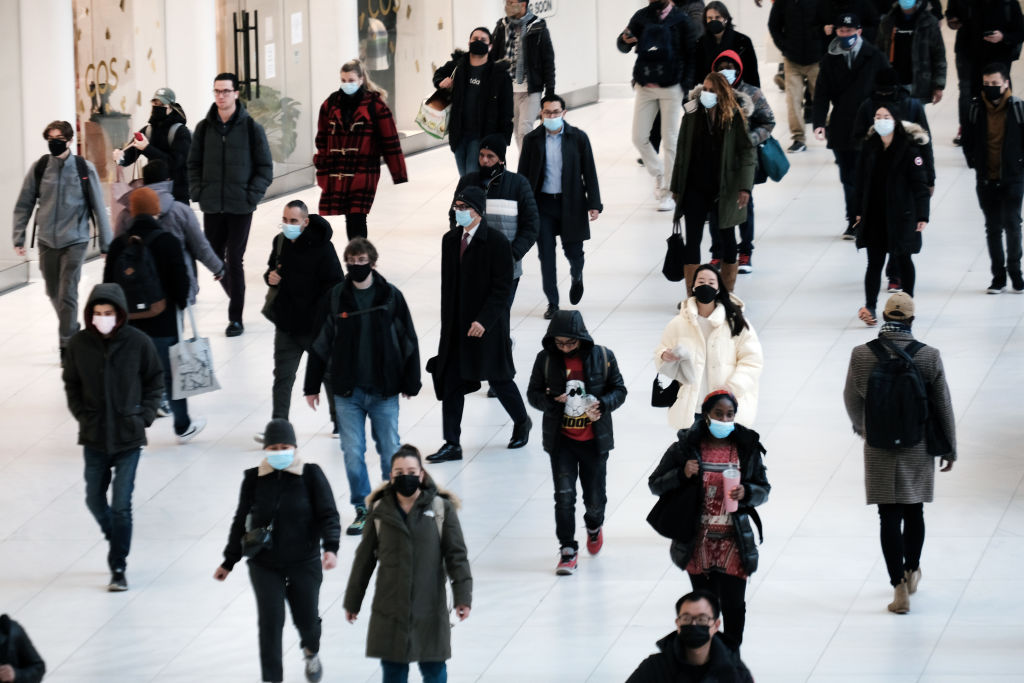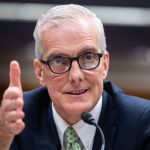In March 2020, a profile of the typical Covid victim emerged from Italy. The average decedent was eighty years old, with approximately three comorbidities such as heart disease, obesity or diabetes. The young had little to worry about; the survival rate for the vast majority of the population was well over 99 percent.
That portrait never significantly changed. The early assessments of Covid out of Italy have remained valid through today. And so it will prove with the Omicron variant.
The data out of South Africa, after five weeks of Omicron spread, suggest that Omicron should be a cause for celebration, not fear. Its symptoms are mild to non-existent in the majority of the infected, especially the vaccinated; hospitalization rates are over nine times lower than for previous Covid strains; deaths are negligible. That assessment will only be confirmed as the US and other western countries gather their own data on Omicron.
Yet the public health establishment and the media are working overtime to gin up Omicron hysteria. The official response to the Omicron variant provides a case study in the deliberate manufacture of fear. The following strategies are key:
1. Create a group norm of fear
The media want you to believe that everyone around you is scared out of his mind, and thus you should be, too. Man-on-the-street interviews quote Nervous Nellies exclusively. A December 17 New York Times article headlined “As Virus Cases Surge, New Yorkers Feel a Familiar Anxiety” trotted out a parade of paralyzed city residents:
“Monday I wasn’t even thinking about [Omicron], and Thursday I’m in a panic,” said a fifty-nine-year-old woman on the Upper West Side. A teacher at Manhattan’s New School confessed: “It’s literally all I’ve been thinking about. I’m really heartsick and worried.” A thirty-six-year-old woman in Fort Greene, Brooklyn, said: “It’s scary — it feels like we’ve been here before.” A sixty-two-year-old woman in Queens reported that her travel and outing days were over: “I’m going to go home, I’m going to stay home and just keep to myself.”
It is not a coincidence that these sources are all female, since females have been the driving force behind safetyism’s conquest of American public policy and of the American mind. Their dominance in corporate HR departments helps explain the constant deferral of back-to-work plans and the restrictions that dominate what little remains of office life.
At Dow Jones, for example, green signs now designate certain desks as “usable;” red signs mark the pariah desks as unusable. Workers who plan to come into the office must be assigned a “usable” desk each day in advance of arrival. The permissible capacity of conference rooms has been shrunk to the point that normal meetings are nearly impossible.
Are there any New Yorkers who are not panicked? Presumably, but you would not know it from the Times’s and other outlets’ coverage. Needless to say, dissenters from Omicron fear in the rest of the country are beneath notice. The point of these one-sided quotes is to spread and normalize panic as the only reasonable reaction to the variant.
***
Get a digital subscription to The Spectator World for just $3.99 a month here
***
2. Buttress group fear with expert opinion
The only public health experts whom the media quote are those determined to put the most dire spin on Omicron. They stress worst-case hypothetical scenarios and dismiss actual good-case evidence. At best, they may grudgingly admit that Omicron symptoms are disproportionately mild, but rush to assert that there are still many as-yet unrealized grounds for worry. “Even if Omicron causes less severe cases, the sheer number of cases could once again overwhelm unprepared health systems,” the director-general of the World Health Organization said. “I’m not counting [Omicron’s lack of severity] as good news just yet,” a disease ecologist at Georgetown University said. “Even if infection is mild in many individuals, it’s not going to be mild in everyone.”
But that 100 percent mildness standard is unrealistic. There are outliers in any disease and any treatment; the question is: what is the predominant reality? The zero-risk, zero-harm standard for public policy adopted for the first time with Covid has proven a social, economic and public health disaster.
At worst, the favored experts do not even pay lip service to the evidence militating against panic. An epidemiologist at the University of North Carolina at Chapel Hill told the New York Times: “I think we need to be prepared for the possibility that this could be at least as bad as any previous wave that we’ve seen.” There are apparently no circumstances which would warrant a less-than-totalitarian response in advance of any actual disaster. The yearning for more draconian lockdowns and more control over the private sector is palpable.
3. Manufacture epistemological uncertainty and insist on that uncertainty as long as possible
The media intone repeatedly that much remains uncertain about Omicron, including how likely it is to cause severe disease. But we already have a good picture of that likelihood from the South Africa experience: very unlikely. Nevertheless, the director of the influential Institute for Health Metrics and Evaluation at the University of Washington, Christopher Murray, is determined to assert that we know little to nothing yet: “The most challenging question is severity,” he told the Times.
4. Bury both good news and dissenters from the bad news
The South African data should lead any coverage of Omicron, yet it has barely been reported. Though only 27 percent of the country is fully vaccinated, less than two percent of new cases are requiring hospitalization. And that number is undoubtedly too high, since many reported Covid hospitalizations were admitted for reasons other than Covid. In countries such as the US with much higher rates of vaccination, the breakthrough infections from Omicron will be even milder. Omicron will be an ideal vehicle for achieving herd immunity, conferring protection without tears on the vast majority of the infected.
The South African doctor who first reported the Omicron variant has declared herself “astonished” by the world’s reaction to the new strain, which is “out of all proportion to its risks.” “Patients typically present with muscle pain, body aches, a headache and a bit of fatigue,” Angelique Coetzee wrote in the Daily Mail on December 13. “After about five days [those symptoms] clear up, and that’s it.” The only patient with severe symptoms whom she has seen over the last month had HIV, pneumonia and other comorbidities.
Coetzee has been nonexistent in the non-conservative press. Just as we are supposed to believe that everyone around us is universally spooked, so we should believe that there is an unbroken expert consensus about the likely disaster that is Omicron. European health officials are warning of an Omicron spike, we are told. State and local health officials are urging that holiday gatherings be held outdoors and that all participants get vaccinated, boosted and tested; partygoers should wear masks. Are there no experts who think that Omicron is not an emerging threat? Apparently not, if you read the mainstream media. If any dissenters do break through, they will be as demonized and silenced by Big Tech as the lockdown skeptics in the scientific community were at the start of the Covid era.
5. Omit relevant context
We hear constantly that 1,300 people are dying a day from Covid. By comparison, about 2,000 people die each day from cancer, and 1,600 from heart disease. Their deaths get no coverage. Covid was the leading cause of death in the US only in January 2021, even among those eighty-five and older. Since then, it has ranked as the third most frequent cause of death both in the overall population and in the elderly.
To read the press coverage, however, you would think that nothing approaches Covid in fierce lethality and that all public resources should be directed to stopping its spread, no matter the costs to the education and socialization of children, to physical and psychological health, and to economic opportunity. Restrictive Covid policies exacerbated sickness in the highest-ranking categories of mortality, a toll that will only grow. Patients put off life-saving cancer screenings, having been spooked away from medical facilities. Obesity worsened, as gyms were shut down and people barricaded themselves at home, packing on the pounds. Those ever-bigger fatties will be tomorrow’s coronary casualties and Covid victims.
Even those 1,300 daily Covid deaths are an overcount, since public health reporting counts deaths with Covid as deaths from Covid. Someone who was dying already from cancer will be deemed a Covid death if he happens to contract that more newsworthy disease at the end of his life. Someone who dies of old age will also be counted as a Covid fatality if infected at death. The average life expectancy in 2019 was less than seventy-nine years. But the New York Times’s maudlin Covid obituaries report the deaths of nonagenarians as Covid fatalities, as if those oldsters would have otherwise lived indefinitely. A ninety-one-year-old jazz pianist was included last week in the “Those We’ve Lost” series, even though he was a stroke victim with numerous longstanding health problems which the Covid virus merely exacerbated.
6. Flog the case count
If the media is obsessing about case count, it means that Covid deaths have been a terrible disappointment. Covid death rates have plunged over the last year and are barely budging in the post-Omicron era. But case counts are a particularly deceptive measure of pandemic severity, when so many of the new cases are mild to asymptomatic. And despite the concerted effort to generate hospital horror stories, hospitalization rates in New York City, the leading wedge of Omicron, remain comparatively low. Covid hospitalization numbers are themselves deceptive, for the same reason as Covid death counts: being admitted to a hospital with Covid is treated as being admitted for Covid.
Monday’s winning entry in the fear-generation sweepstakes went again to the New York Times. A front-page article outlined the anxiety felt by New Yorkers with what once were considered ordinary attributes of a winter cold. “The symptoms of the common cold are typically a stuffy head, the sniffles and body aches,” opened the story. “Now, this season, there’s a new one: panic.”
The usual female sources detailed their terror at the possibility that their runny nose may be Covid. But their illness is equally innocuous either way; labeling it as Covid does not make it any more serious. In fact, they should be delighted if their mild discomfort proves to be Covid (as I was when I tested positive for a breakthrough infection): it means that their immune system has been greatly bolstered against potentially more dangerous future variants, via a sickness that in many cases, such as my own, is far less taxing than a cold.
Nevertheless, the fear-mongering is paying big dividends. Like clockwork, events and businesses in New York City are shutting down, extending the demand for and dependency on government hand-outs.
Radio City has canceled its entire Christmas run of the Rockettes; expect Mayor Bill de Blasio to pull the plug on the Times Square New Year’s celebration.
Broadway shows are booting out already seated audiences if a last-minute test shows just one cast member or technician positive for Covid.
Office parties were called off, depriving caterers of vital revenue. Restaurant reservations are being withdrawn, dashing the industry’s hope for recouping some of its earlier shut-down losses.
Return-to-work schedules are being shelved and entire offices put back on remote work, another severe setback to the revival of midtown Manhattan.
The Metropolitan Opera has announced that no patrons will be allowed inside its cavernous, energetically ventilated auditorium next year unless they have received a booster shot.
Outdoor mask-wearing in Manhattan is back up to about 90 percent, based on informal observation. Masked residents of buildings where virtually everyone is vaccinated are refusing entry to the elevator to their fellow residents (also masked), as if a three-second ride to the lobby will provide enough viral dose to be infectious. Grown men are using their knuckles to press elevator buttons.
Perhaps the rest of the country, particularly in red states, will act more rationally towards Omicron. But here in the epicenter of blue-state dominance, we have turned the equivalent of the common cold into a potent weapon against the resumption of civil society.


















